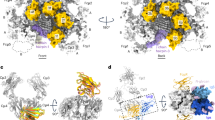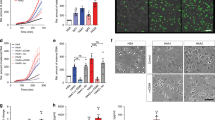Abstract
We have identified the integrin αvβ3 as a ligand for mouse gp49B1, thus identifying a new class of ligand for a member of the family of inhibitory immunoreceptors that bear C2-type immunoglobulin-like domains. The specific interaction was shown by both cell-protein and cell-cell binding assays. In addition, we found that the interaction of αvβ3 with gp49B1 on bone marrow–derived mouse mast cells inhibited antigen-induced immunoglobulin E–mediated cell activation. Because neither gp49B1 nor αvβ3 exhibit substantive allelic variation, their newly appreciated interaction may reflect an innate pathway for down-regulating the activity of mast cells.
This is a preview of subscription content, access via your institution
Access options
Subscribe to this journal
Receive 12 print issues and online access
$209.00 per year
only $17.42 per issue
Buy this article
- Purchase on Springer Link
- Instant access to full article PDF
Prices may be subject to local taxes which are calculated during checkout





Similar content being viewed by others
References
Arm, J. P. et al. Molecular cloning of gp49, a cell surface antigen that is preferentially expressed by mouse mast cell progenitors and is a new member of the immunoglobulin superfamily. J. Biol. Chem. 266, 15966–15973 (1991).
Castells, M. C. et al. Cloning of the gp49B gene of the immunoglobulin superfamily and demonstration that one of its two products is an early-expressed mast cell surface protein originally described as gp49. J. Biol. Chem. 269, 8393–8401 (1994).
Katz, H. R., Benson, A. C. & Austen, K. F. Activation- and phorbol ester-stimulated phosphorylation of a plasma membrane glycoprotein antigen expressed on mouse IL-3-dependent mast cells and serosal mast cells. J. Immunol. 142, 919–926 (1989).
Katz, H. R. et al. Mouse mast cell gp49B1 contains two immunoreceptor tyrosine-based inhibition motifs and suppresses mast cell activation when coligated with the high-affinity Fc receptor for IgE. Proc. Natl Acad. Sci. USA 93, 10809–10814 (1996).
LeBlanc, P. A., Russell, S. W. & Chang, S.-M. T. Mouse mononuclear phagocyte heterogeneity detected by monoclonal antibodies. J. Reticuloendothelial Soc. 32, 219–231 (1982).
Rojo, S., Burshtyn, D. N., Long, E. O. & Wagtmann, N. Type I transmembrane receptor with inhibitory function in mouse mast cells and NK cells. J. Immunol. 158, 9–12 (1997).
Wang, L. L., Mehta, I. K., LeBlanc, P. A. & Yokoyama, W. M. Mouse natural killer cells express gp49B1, a structural homolog of human killer inhibitory receptors. J. Immunol. 158, 13–17 (1997).
McCormick, M. J., Castells, M. C., Austen, K. F. & Katz, H. R. The gp49A gene has extensive sequence conservation with the gp49B gene and provides gp49A protein, a unique member of a large family of activating and inhibitory receptors of the immunoglobulin superfamily. Immunogenetics 50, 286–294 (1999).
Lu-Kuo, J. M., Joyal, D. M., Austen, K. F. & Katz, H. R. gp49B1 inhibits IgE-initiated mast cell activation through both immunoreceptor tyrosine-based inhibitory motifs, recruitment of the src homology 2 domain-containing phosphatase-1, and suppression of early and late calcium mobilization. J. Biol. Chem. 274, 5791–5796 (1999).
Colonna, M. & Samaridis, J. Cloning of immunoglobulin-superfamily members associated with HLA-C and HLA-B recognition by human natural killer cells. Science 268, 405–408 (1995).
D'Andrea, A. et al. Molecular cloning of NKB1. A natural killer cell receptor for HLA-B allotypes. J. Immunol. 155, 2306–2310 (1995).
Moretta, A. et al. P58 molecules as putative receptors for major histocompatibility complex (MHC) class I molecules in human natural killer (NK) cells. Anti-p58 antibodies reconstitute lysis of MHC class I-protected cells in NK clones displaying different specificities. J. Exp. Med. 178, 597–604 (1993).
Wagtmann, N. et al. Molecular clones of the p58 NK cell receptor reveal immunoglobulin-related molecules with diversity in both the extra- and intracellular domains. Immunity 2, 439–449 (1995).
Muta, T. et al. A 13-amino-acid motif in the cytoplasmic domain of FcγRIIB modulates B-cell receptor signalling. Nature 368, 70–73 (1994).
Burshtyn, D. N. et al. Recruitment of tyrosine phosphatase HCP by the killer cell inhibitory receptor. Immunity 4, 77–85 (1996).
Olcese, L. et al. Human and mouse killer-cell inhibitory receptors recruit PTP1C and PTP1D protein tyrosine phosphatases. J. Immunol. 156, 4531–4534 (1996).
Binstadt, B. A. et al. Sequential involvement of Lck and SHP-1 with MHC-recognizing receptors on NK cells inhibits FcR-initiated tyrosine kinase activation. Immunity 5, 629–638 (1996).
Olcese, L. et al. Human killer cell activatory receptors for MHC class I molecules are included in a multimeric complex expressed by natural killer cells. J. Immunol. 158, 5083–5086 (1997).
Campbell, K. S. et al. Signaling through human killer cell activating receptors triggers tyrosine phosphorylation of an associated protein complex. Eur. J. Immunol. 28, 599–609 (1998).
Lanier, L. L. et al. Immunoreceptor DAP12 bearing a tyrosine-based activation motif is involved in activating NK cells. Nature 391, 703–707 (1998).
Lanier, L. L. NK cell receptors. Annu. Rev. Immunol. 16, 359–393 (1998).
Arm, J. P., Nwankwo, C. & Austen, K. F. Molecular identification of a novel family of human immunoglobulin superfamily members that possess immunoreceptor tyrosine-based inhibition motifs and homology to the mouse gp49B1 inhibitory receptor. J. Immunol. 159, 2342–2349 (1997).
Borges, L. et al. A family of human lymphoid and myeloid Ig-like receptors, some of which bind to MHC class I molecules. J. Immunol. 159, 5192–5196 (1997).
Meyaard, L. et al. LAIR-1, a novel inhibitory receptor expressed on human mononuclear leukocytes. Immunity 7, 283–290 (1997).
Samaridis, J. & Colonna, M. Cloning of novel immunoglobulin superfamily receptors expressed on human myeloid and lymphoid cells: structural evidence for new stimulatory and inhibitory pathways. Eur. J. Immunol. 27, 660–665 (1997).
Navarro, F. et al. The ILT2 (LIR1) and CD94/NKG2A NK cell receptors respectively recognize HLA-G1 and HLA-E molecules co-expressed on target cells. Eur. J. Immunol. 29, 277–283 (1999).
Lanier, L. L. Natural killer cells fertile with receptors for HLA-G? Proc. Natl Acad. Sci. USA 96, 5343–5345 (1999).
Hayami, K. et al. Molecular cloning of a novel murine cell-surface glycoprotein homologous to killer cell inhibitory receptors. J. Biol. Chem. 272, 7320–7337 (1997).
Kubagawa, H., Burrows, P. D. & Cooper, M. D. A novel pair of immunoglobulin-like receptors expressed by B cells and myeloid cells. Proc. Natl Acad. Sci. USA 94, 5261–5266 (1997).
Pierschbacher, M. D. & Ruoslahti, E. Influence of stereochemistry of the sequence arg-gly-asp-xaa on binding specificity in cell adhesion. J. Biol. Chem. 262, 17294–17298 (1987).
Coburn, J., Magoun, L., Bodary, S.C. & Leong, J. M. Integrins αvβ3 and α5β1 mediate attachment of lyme disease spirochetes to human cells. Infect. Immun. 66, 1946–1952 (1998).
Blystone, S. D., Graham, I. L., Lindberg, F. P. & Brown, E. J. Integrin αvβ3 differentially regulates adhesive and phagocytic functions of the fibronectin receptor α5β1 . J. Cell Biol. 127, 1129–1137 (1994).
Gurish, M. F. et al. Expression of murine β7, α4, and β1 integrin genes by rodent mast cells. J. Immunol. 149, 1964–1972 (1992).
Colonna, M. et al. A common inhibitory receptor for major histocompatibility complex class I molecules on human lymphoid and myelomonocytic cells. J. Exp. Med. 186, 1809–1818 (1997).
Felding-Habermann, B., Mueller, B. M., Romerdahl, C. A. & Cheresh, D. A. Involvement of integrin αv gene expression in human melanoma tumorigenicity. J. Clin. Invest. 89, 2018–2022 (1992).
Charo, I. F., Nannizzi, L., Smith, J. W. & Cheresh, D. A. The vitronectin receptor αvβ3 binds fibronectin and acts in concert with α5β1 in promoting cellular attachment and spreading on fibronectin. J. Cell Biol. 111, 2795–2800 (1990).
Elices, M. J. et al. VCAM-1 on activated endothelium interacts with the leukocyte integrin VLA-4 at a site distinct from the VLA-4/fibronectin binding site. Cell 60, 577–584 (1990).
Guan, J. L. & Hynes, R. O. Lymphoid cells recognize an alternatively spliced segment of fibronectin via the integrin receptor α4β1 . Cell 60, 53–61 (1990).
Makarem, R. et al. Competitive binding of vascular cell adhesion molecule-1 and the HepII/IIICS domain of fibronectin to the integrin α4β1 . J. Biol. Chem. 269, 4005–4011 (1994).
Humphries, M. J., Sheridan, J., Mould, A. P. & Newham, P. Mechanisms of VCAM-1 and fibronectin binding to integrin α4β1: implications for integrin function and rational drug design. Ciba. Found. Symp. 189, 177–191 (1995).
Emini, E. A., Hughes, J. V., Perlow, D. S. & Boger, J. Induction of hepatitis A virus-neutralizing antibody by a virus-specific synthetic peptide. J. Virol. 55, 836–839 (1985).
Morton, H. C. et al. Immunoglobulin-binding sites of human FcγRI (CD89) and bovine Fcγ2R are located in their membrane-distal extracellular domains. J. Exp. Med. 189, 1715–1722 (1999).
Bazzoni, G., Shih, D. T., Buck, C. A. & Hemler, M. E. Monoclonal antibody 9EG7 defines a novel β1 integrin epitope induced by soluble ligand and manganese, but inhibited by calcium. J. Biol. Chem. 270, 25570–25577 (1995).
Hu, D. D., Hoyer, J. R. & Smith, J. W. Ca2+ suppresses cell adhesion to osteopontin by attenuating binding affinity for integrin αvβ3 . J. Biol. Chem. 270, 9917–9925 (1995).
Matsumoto, Y., Wang, L. L., Yokoyama, W. M. & Aso, T. Uterine macrophages express the gp49B inhibitory receptor in midgestation. J. Immunol. 166, 781–786 (2001).
Matsumoto, Y., Handa, S. & Taki, T. gp49B1, an inhibitory signaling receptor gene of hematopoietic cells, is induced by leukemia inhibitory factor in the uterine endometrium just before implantation. Dev. Growth Differ. 39, 591–597 (1997).
Illera, M. J. et al. Blockade of the αvβ3 integrin adversely affects implantation in the mouse. Biol. Reprod. 62, 1285–1290 (2000).
Van Kooyk, Y. & Figdor, C. G. Avidity regulation of integrins: the driving force in leukocyte adhesion. Curr. Opin. Cell Biol 12, 542–547 (2000).
Rojo, S. et al. Natural killer cells and mast cells from gp49B null mutant mice are functional. Mol. Cell. Biol. 20, 7178–7182 (2000).
Yatohgo, T., Izumi, M., Kashiwagi, H. & Hayashi, M. Novel purification of vitronectin from human plasma by heparin affinity chromatography. Cell Struct. Funct. 13, 281–292 (1988).
Cheng, Y. & Prusoff, W. H. Relationship between the inhibition constant (K1) and the concentration of inhibitor which causes 50 per cent inhibition (I50) of an enzymatic reaction. Biochem. Pharmacol. 22, 3099–3108 (1973).
Johnston, S. C., Dustin, M. L., Hibbs, M. L. & Springer, T. A. On the species specificity of the interaction of LFA-1 with intercellular adhesion molecules. J. Immunol. 145, 1181–1187 (1990).
Acknowledgements
We thank M. Brenner and C. Parker for advice and X.-Y. Wu, L. Rodriguez, B. Sampson, A. Bass, E.Wasser and M. Diaz Jara for technical assistance. Supported by NIH grants AI-01414, AI-07306, AI-22531, AI-31599, AI-41144, AR-45025, AR-47243 and HL-36110 and by grants from the Hyde and Watson Foundation, Arthritis Foundation and Osteogenesis Imperfecta Foundation.
Author information
Authors and Affiliations
Corresponding author
Rights and permissions
About this article
Cite this article
Castells, M., Klickstein, L., Hassani, K. et al. gp49B1-αvβ3 interaction inhibits antigen-induced mast cell activation. Nat Immunol 2, 436–442 (2001). https://doi.org/10.1038/87749
Received:
Accepted:
Issue Date:
DOI: https://doi.org/10.1038/87749
This article is cited by
-
LILRB4 signalling in leukaemia cells mediates T cell suppression and tumour infiltration
Nature (2018)
-
Inhibitory leukocyte immunoglobulin-like receptors in cancer development
Science China Life Sciences (2015)
-
Immunology and Clinical Manifestations of Non-Clonal Mast Cell Activation Syndrome
Current Allergy and Asthma Reports (2013)
-
An immunoglobulin-like receptor, Allergin-1, inhibits immunoglobulin E–mediated immediate hypersensitivity reactions
Nature Immunology (2010)
-
Advances in mast cell biology: new understanding of heterogeneity and function
Mucosal Immunology (2010)



